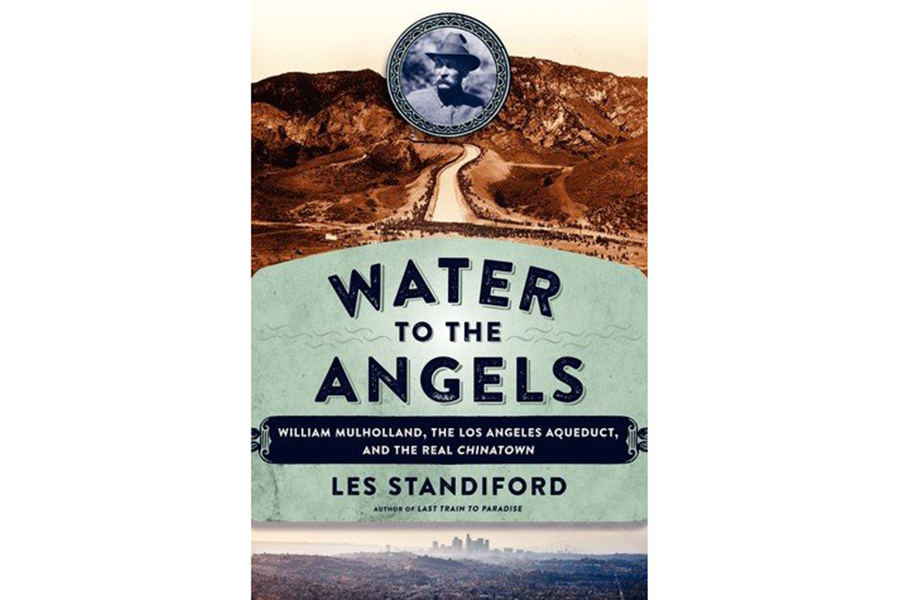The true, heroic, and complex story of how water came to Los Angeles
Loading...
By all (water) rights, a movie about the tangled world of California water politics shouldn’t be gripping. But “Chinatown” is spellbinding, a 1970s classic that still packs a punch.
Just don’t mistake the film for history. The truth of how water came to Southern California is actually more complicated, more heroic and, stunningly, more tragic.
The true-life tale unfolds in the fascinating new book Water to the Angels: William Mulholland, His Monumental Aqueduct, and the Rise of Los Angeles.
Author Les Standiford, a Miami-based historian, is a masterful storyteller, and he expertly captures both the present and past in a state not his own. The book’s star is the Irish immigrant Mulholland, a legendary water engineer and urban visionary who made modern Southern California possible. “Without William Mulholland, there would be no Los Angeles as we know it,” Standiford says.
Mulholland was the powerful force behind an extraordinarily risky and difficult bid to pipe water 233 miles through tough terrain from a remote mountain valley. All this in the early years of the 20th century without pumps to get the water across the state.
As Southern Californians like me rip out lawns and take shorter showers in the arid drought year of 2015, I gave Standiford a call to talk about Mulholland, his moment, and their meaning to us today.
Mulholland “was every important in his way as Lewis and Clark,” he says. Beyond that, he was a “pure public servant” and a man with flair. When asked if he’d run for mayor, he declared, “I’d rather give birth to a porcupine backwards.” A remarkable feat that would be, not unlike bringing water to L.A.
Q: How did you come across the story of William Mulholland?
In the aftermath of “Chinatown” coming out, screenwriter Robert Towne said he’d wished he’d be able to tell the true story as to what had happened since it was just as interesting as what he’d made up.
That idea never really left me.
Q: What did you discover about Mulholland as you researched this book?
There’s a kind of “Chinatown” syndrome that implies he was a crook or at least in league with crooks or looked the other way. The enormity of his accomplishment has been overlooked. That made me want to tell the story.
Q: In 1900, years before Mulholland went to work on his grand project, Los Angeles was just the 36th most-populous city in the country. Only about 102,000 people lived there, and Omaha, Toledo, and Fall River, Mass., were larger. Even then, though, Angelenos had water on their minds. What challenges did they face in a place that only gets about 15 inches of rain a year?
From the very beginning, the Indians had trouble living there. It was a real act of resolve to plant the Spanish flag there, since no one could live more than a mile or so from the Los Angeles River.
People argue that 125,000 or 250,000 or 300,000 people could have been supported by the river. Whatever the case, there’s no way in the world that the natural resources of Los Angeles could support today’s population of 10 million without water from somewhere else.
If there hadn’t been an aqueduct, you wouldn’t have had a Santa Monica or a Hollywood and on and on.
Q: What set Mulholland apart that allowed him to not only envision a massive and challenging aqueduct project but also make it happen?
He was in love with his subject. He was fascinated by issues of water, and he divined its importance to a city in a desert. A legend grew around him as a man who knew everything about water in Los Angeles.
At one point, after he had completed the aqueduct for the city about five years after coming on board, he was far and away the most popular individual in Los Angeles.
He could have won the race for mayor in a cakewalk, and he was asked to run by business interests who were afraid of a socialist candidate. But he said he’d rather “give birth to a porcupine backward.” He was a true public servant. He loved what he was doing, and he realized how important it was.
Q: How big of a challenge was this aqueduct?
You’re bringing a river from the east side of the Sierra Nevadas, 233 miles over chasms and ravines, across a desert, and to a city and the sea, using no pumps, only gravity.
Q: Without giving too much of your book away, an epic dam failure destroyed Mulholland’s career. While little-remembered today, it’s still the second-deadliest disaster of any kind in California’s history. What was his response when he faced accusations of letting it happen?
He said, “If you’re looking for human error, fasten it on me. I built it, I designed it, I failed. I’m responsible.” But to this day, no one believes that Mulholland was personally responsible.
Q: What is the message of Mulholland’s life’s work for the drought-stricken California of today?
If Mulholland were alive, if we were able to ask him, he would say: “Get yourself the best water man there is. Set the task before him and get out of his way.”
What we have now is the interference of politics. What Mulholland had going for him was that everyone respected him, and many people loved him.
He said, “We were going to get water from this river from the Owens Valley, even if it seems impossible, and I know we can do it.” He did exactly what he said he was going to do.
The politicians liked him, the people liked him, and more importantly they trusted him.
Randy Dotinga, a Monitor contributor, is president of the American Society of Journalists and Authors.







